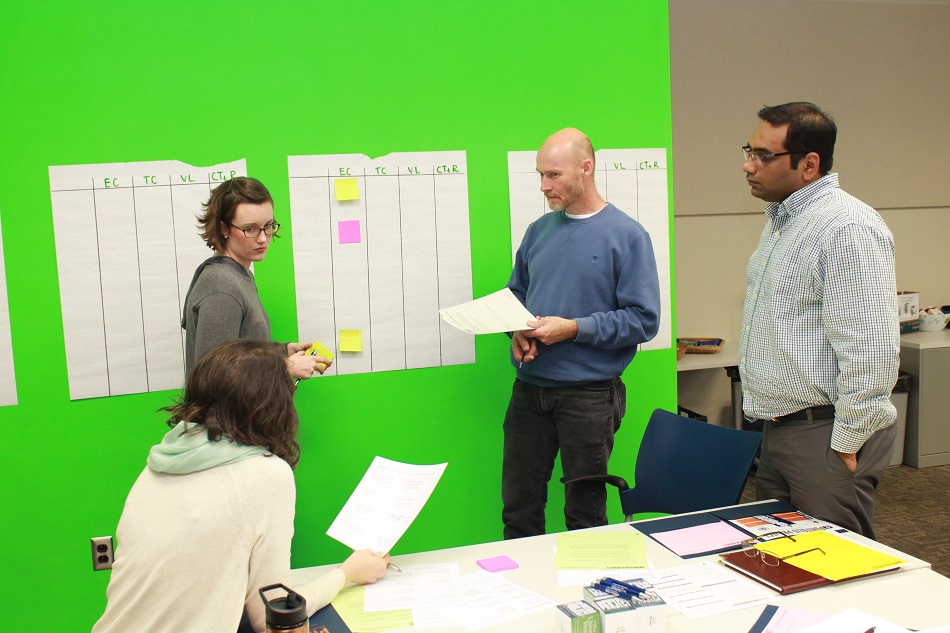Faculty collaboration is built into the structure of the ePortfolio Project at Auburn University. The initiative operates on a cohort model, which is essentially a learning community made up of faculty, staff, and administrators. As Bartlett has discussed elsewhere (Maki, forthcoming), essential characteristics of the ePortfolio Project Faculty Cohort include cross-disciplinary collaboration, opt-in participation, and flexibility. The Cohort is designed to empower faculty to prioritize student learning.
The ePortfolio Project is our QEP (Quality Enhancement Plan) for SACSCOC (Southern Association of Colleges and Schools Commission on Colleges) accreditation. According to the association's website, the QEP “describes a carefully designed and focused course of action that addresses a well-defined topic or issue(s) related to enhancing student learning" (2015). In Reclaiming Accountability: Improving Writing Programs through Accreditation and Large-Scale Assessments, Sharer, Morse, Eble, and Banks write, “As institutions of higher learning have increasingly been asked to account for student learning and to take action to improve their student learning, accreditation and the large-scale assessment it entails become one driver of this work" (2016, 5). The ePortfolio Project aims to make the most of the occasion the QEP provides by engaging faculty and students in meaningful learning experiences.
The Cohort brings together faculty, staff, and administrators from, to date, upwards of 30 academic and co-curricular units from across campus. We encourage participants to join the Cohort in small groups from the same program so that they can work together to integrate ePortfolios into their curriculum. The central office for the ePortfolio Project is housed in the Office of University Writing, which reports to the Provost and serves the entire campus community. To support the work of the Cohort, the ePortfolio Project offers a wide range of programming and support, including but not limited to:
- topics-based workshops (like curriculum mapping, teaching reflective writing, and teaching visual literacy),
- Cohort Chats (where Cohort members share lunch and conversation around topics related to ePortfolio pedagogy),
- customized classroom presentations and workshops to meet individual Cohort members’ needs,
- individual or group consultations, and
- web resources to support ePortfolio pedagogy .
The ePortfolio Project also has a grants program to support faculty and staff as they integrate ePortfolios into their curricula.
Cohort members report that the ePortfolio Project creates opportunities for cross-disciplinary conversation and collaboration that they don’t otherwise have. Moreover, learning from colleagues in other disciplines is not only intellectually engaging for them, but also enriches the work they do in their own disciplines. According to the Tracer Project, which is detailed in the 2016 book Faculty Development and Student Learning: Assessing the Connections, one of the conditions that enables productive cultures of teaching and learning to emerge is “faculty development that encourage[s] shared effort across disciplines to improve teaching and learning" (Condon et al., 11). Our aim is for the ePortfolio Project to create these kinds of faculty development opportunities. The picture below shows faculty and staff from our Poultry Science Department working together to map ePortfolio Project student learning outcomes into their curriculum. Small groups of faculty from Geosciences, Curriculum and Teaching, Animal Sciences, Theatre, Forestry and Wildlife Sciences, and Nursing also participated in the curriculum mapping workshop.

The ePortfolio Project Cohort is opt-in, so academic and co-curricular units join when they decide ePortfolios make sense for their students in their context. They may apply to join in whatever configuration makes the most sense for them, so sometimes single programs join and sometimes entire schools or departments join. For example, the entire School of Nursing is part of the Cohort, as is the Master of Public Administration program in the Department of Political Science (the MPA program is a Cohort member; their entire department, to date, is not). The decision to make the ePortfolio Project opt-in for faculty was made by the QEP development committee early in the development process, as was the decision to use free online platforms rather than purchase a platform that everyone would have to use. Because we wanted to be as inclusive as possible—and because some faculty from across disciplines view technology as superfluous to their pedagogical goals and/or intimidating to teach—we de-emphasized the role of technology in our early implementation efforts in favor of emphasizing the reflective and communicative potential of the ePortfolio; as we progress in implementation, however, faculty in the Cohort are learning what the technology makes possible for them and their students.
From the outset, the ePortfolio Project’s primary purpose has been to provide a meaningful learning experience for students, and the development committee was confident that empowering faculty and students to make choices was the best way to forward that cause. Although we originated as the QEP, we hope to be an example of “how a seemingly top-down requirement, imposed from outside of the institution, can be used to facilitate, rather than impede, faculty-driven change" (Sharer et al. 2016, 11), and we did—and continue to do—our best to put a structure in place that would not only enable faculty-driven change, but also empower faculty to imagine how best to implement ePortfolios in their contexts for their purposes.
The following examples from Biosystems Engineering, English Education, and Nursing are three illustrations of how Auburn University faculty members in disparate disciplines have taken up the ePortfolio Project and tailored the existing structure to their purposes within their disciplinary contexts. Even though these Cohort programs focus on different learning possibilities of the ePortfolio—critical thinking, identity development, and professional development—a commitment to the learning potential of reflective writing is what binds them together. Our aim is to offer snapshots that illustrate what is made possible when ePortfolio initiatives lead with student learning.